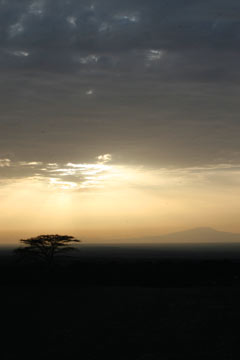|
FEATURE
Out
of
Africa:
Following the Arabian Trail
Erin Wayman
In the spring of 2006, a team of divers descended into the turquoise waters of the Red Sea, just offshore of one of the limestone islands in the Farasan Islands archipelago. Outfitted with cameras, measuring tapes and special deep-sea scuba gear, the team wasn’t there to admire the colorful corals or vibrant fish that attract most divers to the island chain located 40 kilometers off Saudi Arabia’s southwestern coastline. Instead, they were searching for a rare treasure: submerged traces of our ancestors’ journey out of Africa.
The human fossil record and studies of human genetic diversity agree on the origins of our species: Sometime nearly 200,000 years ago, Homo sapiens emerged in Africa. Then, by 50,000 years ago, a group of these modern humans ventured from their African homeland into the unknown. Descendants of these early explorers eventually made their way across the entire globe, yet the oldest-known successful human population outside of Africa comes from an unlikely place — Australia, where human fossils show our ancestors reached the island continent by at least 45,000 years ago. This fossil evidence and studies of genetics together suggest that humans headed to India and the isolated islands of the Indian Ocean before migrating into Europe or northern Asia tens of thousands of years later. The exact route these early humans used to leave Africa, however, is debated.
Unlike the divers off the Farasan Islands, most archaeologists don’t comb the seafloor when looking for evidence of these journeys out of Africa. Instead, they tend to focus on excavating in the Middle East’s Levant region, an area that encompasses modern Israel, Palestine, Lebanon, Jordan and Syria. And it’s not hard to understand why — the only land bridge that connects Africa with Eurasia is Egypt’s Sinai Peninsula, making it seemingly the easiest route for our ancestors to have used on their way out of Africa.
Yet there may have been another way out. Situated prominently between Africa and Eurasia, the Arabian Peninsula’s role in the human expansion from Africa has long been overlooked; however, some archaeologists assert that our ancestors could have traveled across the Bab al-Mandeb Strait — the narrowest part of the Red Sea that separates the Horn of Africa from the Arabian Peninsula. Traditionally, critics claimed that crossing the Red Sea, even at its narrowest point, and traversing the Arabian Peninsula would have been too difficult for our ancestors. But with mounting genetic evidence hinting that at least some modern humans probably did march across southern Arabia, a handful of archaeologists have taken on the challenges of working in the peninsula’s harsh desert environment and below the sea to investigate the early human archaeology of this neglected subcontinent.
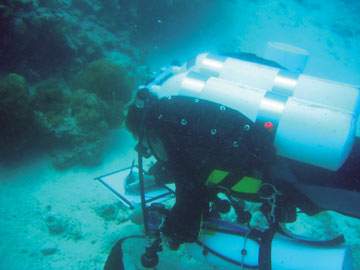 Courtesy of Geoff Bailey |
| A diver off the Farasan Islands in the Red Sea searches the seafloor for clues on where to look for early human archaeological sites. |
A Southern Route
That modern humans left the continent via the Horn of Africa and followed what’s been dubbed a “southern route” as they migrated through Arabia on their way eastward is an idea that’s been “tossed around since the 1980s,” says Michael Petraglia of the University of Cambridge in the United Kingdom. But it’s only recently gained traction, thanks to genetics.
Most recent studies of mitochondrial DNA — DNA inherited from the mother — indicate that modern human populations outside of Africa can be traced back to one genetic lineage that originated in Africa roughly 85,000 years ago, according to Peter Forster of Anglia Ruskin University in the United Kingdom. Sometime between 85,000 and 55,000 years ago, members of this founding lineage left the continent and branched out into the three main genetic lineages that are found in Eurasian populations today. By studying the diversity within these genetic lineages, researchers can estimate how far back in time these lineages evolved. Such studies indicate that humans reached South Asia very early, before Europe or North Asia. For example, Vincent Macaulay of the University of Glasgow in the United Kingdom and colleagues reported May 13, 2005, in Science that the origins of the mitochondrial lineages of aboriginal populations living in Malaysia date to nearly 60,000 years ago. Because humans reached Southeast Asia and Australia before more northern locations, some researchers suggest humans likely followed a migration path along the coastlines of South Asia after initially leaving Africa and only later traveled through the interior parts of the continent.
To reach the coasts of South Asia, humans had two possible African exit strategies. They could have left via a northern route from the Sinai Peninsula, heading north into the Levant, and traveling east across modern Iraq’s Zagros Mountains before turning south toward modern Iran. Alternatively, they could have left via a southern route from the Horn of Africa, crossing the Bab el-Mandeb Strait, and traveling across southern Arabia before heading directly into Iran. Leaving Africa via the southern route, proponents claim, explains why humans colonized South Asia so quickly in comparison to Europe and North Asia.
Geoff Bailey, an archaeologist at the University of York in the United Kingdom, interprets the genetic data cautiously. The patterns of human ancestry inferred by genetics are producing models of human migration, he says, but these models need to be tested with independent lines of evidence. To do this, researchers need fossils and artifacts that place modern humans along the proposed routes of their African exodus. Petraglia, who has worked in Saudi Arabia, agrees: To begin with, this means working in Arabia. But this is easier said than done, given that the archaeology in Arabia is virtually unknown, the logistics of working in its vast rolling sand dunes are difficult at best, and political tensions in the area have discouraged many from entering the region. Yet despite all the obstacles, “it’s becoming a very popular area to look at because these models are suggesting it could be important,” Bailey says.
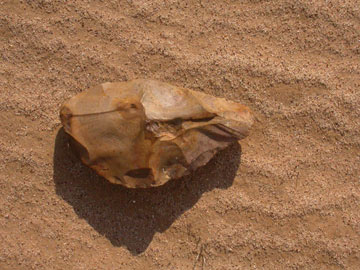 Courtesy of Jeffrey Rose |
| Stone tools such as this one, found in southern Arabia, are also found in Africa. |
The few archaeologists already working in the region say they’re beginning to find the evidence necessary to tie our African ancestors to Arabia. Presumably, when humans first left Africa, they didn’t leave empty handed; they would have brought with them all the necessary tools for survival. The stone tools archaeologists find in southern Arabia, therefore, should match those on the African side of the Red Sea. In Saudi Arabia, Petraglia has found stone tools near ancient lakeshores that resemble those of the African Middle Stone Age, although he admits formal analyses are needed to substantiate these claims. In other studies, Amanuel Beyin, a graduate student at Stony Brook University in New York, has compared tool assemblages from the Horn of Africa, the Nile River Valley, Arabia and the Levant, and found that the African tools share the most similarities with the tools from Arabia, which, for example, share in common arrow-head-like Aterian points that are absent from the Levant assemblages. Since 2005, Beyin has been working to further the scope of the African evidence by excavating sites in Eritrea that have Middle Stone Age artifacts.
As suggestive as this preliminary evidence might be, it’s far from definitive because all these artifacts lack one crucial element: dates. Due to the erosional nature of the Arabian landscape, archaeological sites are either below meters-thick mounds of sand or are blown away from the surface, says Jeffrey Rose, an archaeologist at Oxford Brookes University in the United Kingdom who works in Oman. Finding an intact site with nicely layered stratigraphy is virtually impossible, thus making it difficult to get the necessary ages for the Arabian tools to properly correlate them with African tools. “It’s easy to find sites on the surface,” Rose says, “which is a testament to the density and length of [human] occupation in Arabia. But what we need are stratified, dated sites with tools.” And Bailey notes that the erosion also leads to poor preservation of the artifacts, further obfuscating the situation.
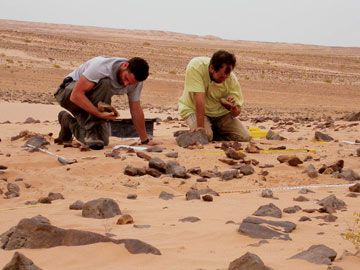 Courtesy of Jeffrey Rose |
| Jeffrey Rose, left, and a colleague comb through the sand in Oman as they look for stone tools left behind by early humans. |
This hasn’t discouraged researchers working in the region, however. Instead, it’s forced them to think outside the box — or rather, to consider what evidence may rest below the sea.
What Lies Beneath
Today, if you stand on the shores of Djibouti and peer across the Bab al-Mandeb Strait, you’ll be greeted by a panoramic view of the Yemini Highlands on the Arabian side of the Red Sea. Would the 30 kilometers of water that separates the two shores have been enough of a barrier to prevent early modern humans from getting from one continent to another? Of course, this really isn’t the appropriate question to contemplate, as sea levels have continuously ebbed and flowed in line with climatic changes during our species’ tenure on Earth.
Instead, some researchers have wondered whether there could have been a dry passage between Africa and Arabia at some point in the past. Bailey and his colleagues recently tackled this question by comparing data on global sea-level changes over time with bathymetric data from the Red Sea. They determined water has always separated Africa and Arabia for at least the past 2 million years, as they reported in the Journal of Island & Coastal Archaeology last July. “You could never get across there without getting your feet wet,” Bailey says. “It’s a matter of opinion if it’s a barrier or a gateway to a population with no boats, or raft technology at best.” But during periods of low sea level, the channel would have been much narrower than it is today, he adds.
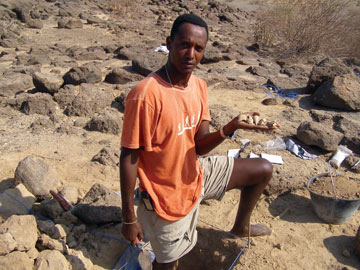 Courtesy of Amanuel Beyin |
| Amanuel Beyin shows shells that he has discovered in archaeological assemblages in Eritrea, which provide proof that these areas were once along the coast of the Red Sea. |
Because sea levels have continuously changed, so have the coastlines. If our ancestors did navigate a narrow strait across the Red Sea and inhabit the coastal locales of Arabia, remnants of these ancient communities may now rest at the bottom of the Red Sea. This is a blessing in disguise. Although underwater archaeology brings with it a host of challenges, the archaeological sites resting beneath the waves may actually be better preserved than the surface sites on mainland Arabia, Bailey says. And the sunken artifacts are likely preserved in situ, providing researchers with an opportunity to estimate the age of any stone tools — or human fossils — they might recover.
In the spring of 2006, as part of a joint Saudi-U.K. project, Bailey and his international crew began preliminary underwater investigations in the Red Sea near the Farasan Islands, which have been connected to mainland Arabia during periods of low sea level in the past. But before they could dive right in and start digging up tools, they needed to know where to look for any potential artifacts. So, Bailey and his team started assessing the locations of ancient shorelines. To do this, they have relied on remnants of past shorelines from periods of higher sea levels that lie further inland on the islands’ coasts as examples of what they should be looking for underwater. For example, because the Farasan Islands are coral platforms, wave action triggers chemical reactions that undercut the coral and create distinctive ledges, Bailey says. “We’ve been looking for similar features underwater. And sure enough, we have found them,” he says. The next step is to fully map out these underwater features using seismic and sonar technology before the team can finally begin to look for archaeological sites. This next phase will likely begin later this year, when the crew plans to return to the Farasan Islands.
A Coastal Refuge
The ability to live on the coast and utilize marine resources may have been a key behavioral innovation that allowed our ancestors to undertake their large-scale migration out of Africa along a southern route, some researchers say. Living and traveling along the coasts would have made the human dispersal from Africa much easier and more efficient, according to archaeologist Paul Mellars of the University of Cambridge who wrote a review on the topic in Science on Aug. 11, 2006. Mellars notes that coastal habitats change little from region to region, unlike interior environments. Movement along the coasts would have minimized the need for humans to adapt to changing local conditions.
In fact, the original trips out of Africa may have been spurred by humans looking for coastal oases during dry glacial periods. While creatures living in more northern latitudes had to contend with advancing ice sheets during glacial periods, those living in the tropics dealt with increasingly arid conditions. At a time when many previously suitable environments in Africa deteriorated, the coasts, although their shorelines were changing, still provided a sustainable supply of resources, Bailey says. And because sea levels were lower, crossing over to Arabian coastal areas would have been more manageable.
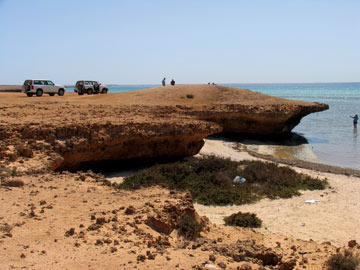 Courtesy of Geoff Bailey |
| Undercut coral platforms are found throughout the Farasan Islands, demarcating ancient shorelines from periods of higher sea level. |
Rose agrees that these coastal areas would have served as important refuges to early humans, but he has his own take on migration into and out of Arabia. During dry periods in the past, mainland Arabia was the harsh, arid desert it is today. During wet periods, however, it became a lush, fertile region that welcomed not only humans but other African flora and fauna as well. And when dry periods returned, some of these displaced African populations got stuck in coastal refuges. One important refuge, according to Rose, was along the modern Persian Gulf, which would have provided early humans with both marine resources and exposed sources of freshwater that normally flow beneath the peninsula when sea levels are high.
It is from this Persian Gulf refuge that modern humans may have launched their large-scale migration east, rather than directly from Africa, Rose says. Of course, modern humans evolved in Africa, but Rose suggests that much of the world’s genetic diversity might have emerged from a population outside of Africa. For example, geneticists do not know for certain when the world’s three main mitochondrial lineages — M, N and R — branched from the founding African lineage, L3. But estimates of the ages of the world’s oldest M lineages, found in modern African, Indian and southwest Arabian populations, overlap in time, Rose says. This means the initial divergence of L3 might have happened in Africa, or it might have happened in India or southwest Arabia. “The verdict is still out there,” Rose admits, but he says a lot of genetic variability seems to cluster around southwest Arabia — an indicator that modern human dispersals might have originated in the region.
For now, Rose’s hypothesis is still very much in its infancy, requiring much further evidence and testing. “I’m not trying to sell anyone an idea,” he says. “I’m just trying to figure out what happened.”
At the very least, Rose and others hope their unconventional ideas will draw more researchers — who can help determine whether modern humans really employed a southern route out of Africa — to the Arabian Peninsula. “Modern human genetics has helped, and the archaeology is highly suggestive,” Petraglia says, “but a lot more data needs to be collected.”
Links:
Anthropology.net
"Tracing Human Migration," Geotimes, September 2005

 Subscribe
Subscribe

